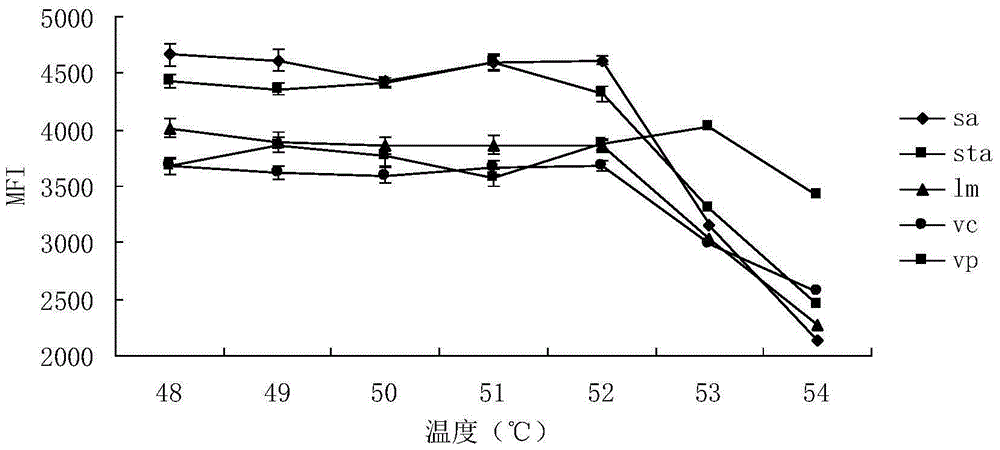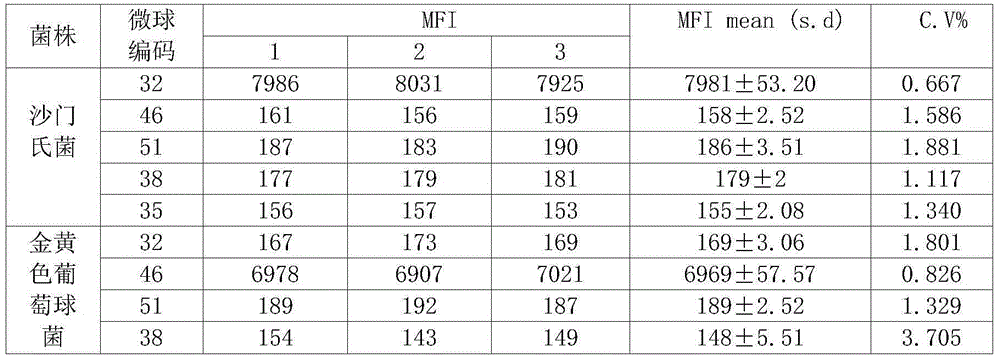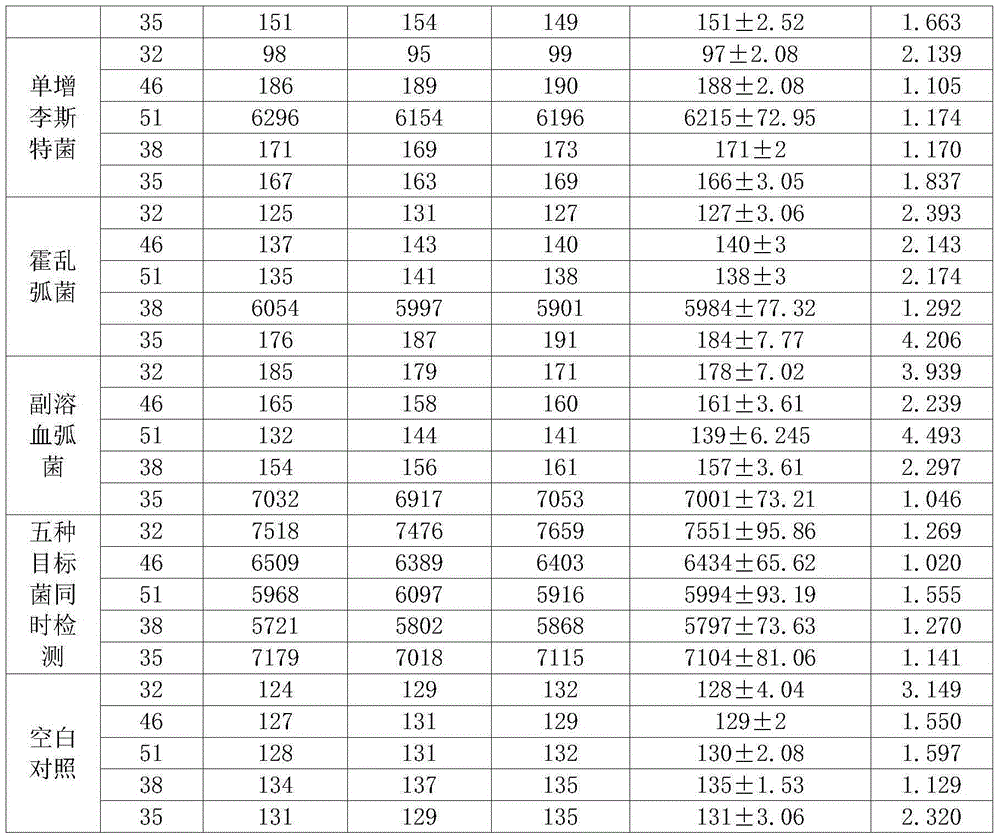Gene probe for simultaneously detecting five food-borne pathogenic bacteria through liquid chip and detection method
A food-borne pathogenic bacteria, liquid-phase chip technology, applied in microorganism-based methods, biochemical equipment and methods, and microbial assay/inspection, etc., to achieve the effects of low cost, strong primer specificity, and strong stability
- Summary
- Abstract
- Description
- Claims
- Application Information
AI Technical Summary
Problems solved by technology
Method used
Image
Examples
Embodiment 1
[0055] A gene probe for simultaneous detection of five food-borne pathogenic bacteria by using a liquid chip, including the following gene probes for detecting five food-borne pathogens:
[0056] Probes for the detection of the invasion protein invA gene of Salmonella:
[0057] The nucleotide sequence of its probe is NH 2 -5'TTTTTTTTTTTTTACCTATCTGGTTGATTTCCTG-3';
[0058] Probes for the detection of the Hly gene of Listeria monocytogenes:
[0059] The nucleotide sequence of its probe is NH 2 -5'TTTTTTTTTTTTTCGCCTGCAAGTCCTAAGA-3';
[0060] Probes for the detection of the sa442 gene of Staphylococcus aureus:
[0061] The nucleotide sequence of its probe is NH 2 -5'TTTTTTTTTTTTTTGCATCGGAAACATTGT-3';
[0062] Probes for detecting the hlyA gene of Vibrio cholerae:
[0063] The nucleotide sequence of its probe is NH 2 -5'TTTTTTTTTTTTATGCGATTGCCCAAGA-3';
[0064] Probes for detecting the toxR gene of Vibrio parahaemolyticus:
[0065] The nucleotide sequence of its probe is ...
Embodiment 2
[0085] Step 4: Coupling the gene probes of five kinds of food-borne pathogenic bacteria with the microspheres to obtain the microsphere probes and verification, the verification method and results are shown in Example 2;
[0086] The coupling of probes and microspheres is carried out according to the operation steps recommended by Luminex:
[0087] ①. Take a fresh EDC powder frozen at -20°C and packed at room temperature.
[0088] ②. The modified -NH 2 The oligonucleotides were diluted with sterilized deionized water and resuspended to 1 mmol / L, which was the storage concentration.
[0089] ③. Take the concentration as 5.0×10 6 pcs / mL R&D microspheres or color-coded microspheres, shake to mix, and sonicate for 20s to resuspend the microspheres.
[0090] ④. Pipette 200uL microspheres into a brown Eppendorf tube, centrifuge the microspheres at 8000g for 2min, discard the supernatant.
[0091] ⑤. Add 50 ul of MES (pH 4.5) with a concentration of 0.1 mol / L, shake to mix, and s...
Embodiment 3
[0120] Example 3 Optimization of liquid phase chip hybridization temperature
[0121] The optimal conditions for hybridization of oligonucleotide probes are to ensure the specificity of hybridization and to form stable hybrids at an appropriate rate. The longer the probe sequence, the easier it is to form a hybrid, but it lacks specificity and the hybridization rate slows down. Short probes have higher specificity but suffer from unstable hybrid defects. Temperature has a significant impact on the hybridization effect. Selecting the most appropriate hybridization temperature can enhance specific hybridization and reduce the fluorescence intensity of non-specific hybridization. In this study, five different probes were used as the research objects to optimize the hybridization temperature.
[0122] Configure the microsphere solution: dilute the microsphere probe with the microsphere diluent, and prepare 5 times according to the test volume: take 100 μL of the microsphere dilu...
PUM
| Property | Measurement | Unit |
|---|---|---|
| diameter | aaaaa | aaaaa |
Abstract
Description
Claims
Application Information
 Login to View More
Login to View More - R&D
- Intellectual Property
- Life Sciences
- Materials
- Tech Scout
- Unparalleled Data Quality
- Higher Quality Content
- 60% Fewer Hallucinations
Browse by: Latest US Patents, China's latest patents, Technical Efficacy Thesaurus, Application Domain, Technology Topic, Popular Technical Reports.
© 2025 PatSnap. All rights reserved.Legal|Privacy policy|Modern Slavery Act Transparency Statement|Sitemap|About US| Contact US: help@patsnap.com



